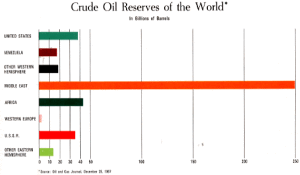
In this 1967 chart, the Middle East is the fourth bar down and clearly the leading region in terms of “Crude Oil Reserves of the World.” But as it turned out, this chart represented only one category of crude oil reserve.
By Bill Kovarik, PhD
(First published in 2002).
- Middle Eastern oil in perspective
- Comparison of USGS and oil industry reserve estimates
- Unconventional oil reserves
- World media has one view of oil reserves
- World oil reserve figures vary considerably in history
- Conclusion and References
In this 1967 chart, the trade magazine Oil and Gas Journal presents the oil industry’s exaggerated view of the importance of the Middle East to the world. Here the Middle East is shown with something like 250 billion barrels of crude oil reserves. Only 23 years beforehand, Middle East reserves were estimated at 16 billion barrels. By the 1990s the Middle East was over 500 billion.
Timeline
• 1857 — Romania produces 2,000 barrels of oil, marking the beginning of the modern oil industry.
• 1859, Aug. 25 — Edwin L. Drake strikes oil in Titusville, Pennsylvania
• 1862 — First commercial oil production in Canada, also 1863 in Russia.
• 1862 — Most widely used lamp fuel (camphene) taxed in US at aprox. $1 a gallon; kerosene taxed at 10 cent per gallon. (Kovarik, 1997)
• 1863 — John D. Rockefeller starts the Excelsior Refinery in Cleveland, Ohio.
• 1879 — US Geological Survey formed in part because of fear of oil shortages.
• 1882 — Institute of Mining Engineers estimates 95 million barrels of oil remain. With 25 milliion barrels per year output, “Some day the cheque will come back indorsed no funds, and we are approaching that day very fast,” Samuel Wrigley says. (Pratt, p. 124).
• 1901 — Spindletop gusher in Texas floods US oil market.
• 1906 — Fears of an oil shortage are confirmed by the U.S. Geological Survey (USGS). Representatives of the Detroit Board of Commerce attended hearings in Washington and told a Senate hearing that car manufacturers worried “not so much [about] cost as … supply.”
• 1919, Scientific American notes that the auto industry could no longer ignore the fact that only 20 years worth of U.S. oil was left. “The burden falls upon the engine. It must adapt itself to less volatile fuel, and it must be made to burn the fuel with less waste…. Automotive engineers must turn their thoughts away from questions of speed and weight… and comfort and endurance, to avert what … will turn out to be a calamity, seriously disorganizing an indispensable system of transportation.”
• 1920 — David White, chief geologist of USGS, estimates total oil remaining in the US at 6.7 billion barrels. “In making this estimate, which included both proved reserves and resources still remaining to be discovered, White conceded that it might well be in error by as much as 25 percent.” (Pratt, p. 125. Emphasis added).
• 1925 — US Commerce Dept. says that while U.S. oil production doubled between 1914 and 1921, it did not kept pace with fuel demand as the number of cars increased.
• 1928 — US analyst Ludwell Denny in his book “We Fight for Oil” noted the domestic oil shortage and says international diplomacy had failed to secure any reliable foreign sources of oil for the United States. Fear of oil shortages would become the most important factor in international relations, even so great as to force the U.S. into war with Great Britain to secure access to oil in the Persian Gulf region, Denny said.
• 1926 — Federal Oil Conservation Board estimates 4.5 billion barrels remain.
• 1930 — Some 25 million American cars are on the road, up from 3 million in 1918.
• 1932 — Federal Oil Conservation Board estimates 10 billion barrels of oil remain.
• 1944 — Petroleum Administrator for War estimates 20 billion barrelsof oil remain.
• 1950 — American Petroleum Institute says world oil reserves are at 100 billion barrels. (See Jean Laherre, Forecast of oil and gas supply)
• 1956 — M.King Hubbard predicts peak in US oil production by 1970.
• 1966 – 1977 — 19 billion barrels added to US reserves, most of which was from fields discovered before 1966. (As M.A. Adelman notes: “These fields were no gift of nature. They were a growth of knowledge, paid for by heavy investment.”)
• 1973 — Oil price spike; supply restrictions due to Midde Eastern politics.
• 1978 — Petroleos de Venezuela announces estimated unconventional oil reserve figure for Orinoco heavy oil belt at between three and four trillion barrels. (More recent public estimates are in the one trillion range).
• 1979 — Oil price spike; supply restrictions due to Midde Eastern politics.
• 1980 — Remaining proven oil reserves put at 648 billion barrels
• 1993 — Remaining proven oil reserves put at 999 billion barrels
• 2000 — Remaining proven oil reserves put at 1016 billion barrels.
• 2005 — Oil price spike; supply restrictions and heavy new demand
• 2006 — Saudi Aramco dismisses “peak oil” concerns, estimating conventional reserves at 4,500 billion (4.5 trillion) barrels of recoverable oil.
• 2010 — Gas reserve estimates expand in the US with hydraulic fracturing
• 2012 — World oil reserve estimates expand to account for conventional resources not counted in the old proven reserve system.
